What to Wear Hiking in Fall: The Ultimate Guide
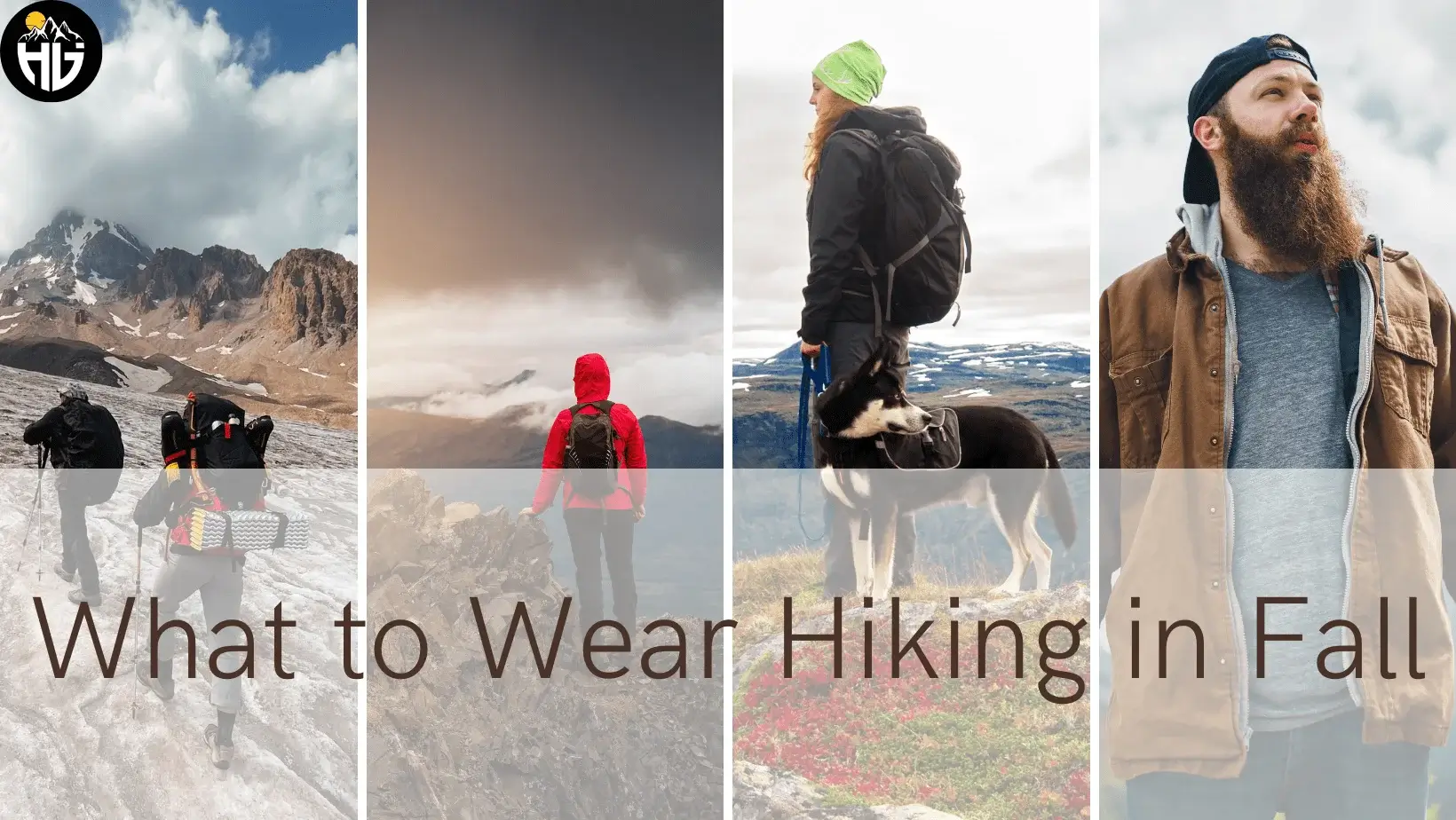
Fall is considered to be a prime hiking season for wanderers. It’s the perfect time of year to explore the outdoors because of the crisp air, vibrant foliage, and serene surroundings.
However, you should ensure that you are wearing proper hiking clothes for the weather as it changes. The right clothing is crucial for comfort, safety, and enjoyment during an autumn hike.
Everything you need to know about what to wear hiking in fall will be covered in this article. We’ll talk about how important fall hiking outfit is and offer advice on base layers, mid layers, outer layers, and accessories.
This guide will help you prepare for your upcoming autumn hike, whether a beginner or an experienced hiker. It will ensure you have a comfortable and enjoyable experience. So let’s dive in and learn more about fall hiking clothes!
Base Layers to wear while Hiking in Fall

It serves as the framework for your fall hiking outfit and is essential for managing moisture. These layers, which are near your skin, remove sweat from your body and keep you dry and comfortable.
Base layers assist you in maintaining a constant body temperature while hiking in fall, when temperatures change quickly. This is true whether you’re going uphill or downhill.
Recommended materials
Look for lightweight, moisture-wicking fabrics and quick-drying when selecting materials for base layers. Merino wool, synthetic materials like polyester, and bamboo are some of the best for fall hiking outfit.
These materials are breathable and aid in controlling body temperature, making them perfect for hiking in the changing autumn weather.
Recommended types
Tops and bottoms are the two different categories of base layers. T-shirts and long-sleeved shirts are tops, and white shorts, tights, and trousers are examples of bottoms.
Choose a long-sleeve shirt and full-length trousers or tights for autumn hiking to offer plenty of coverage and weather protection.
When selecting the best base layer for your autumn hike, consider the weather and your personal preferences.
Tips for choosing the right base layer for fall hiking clothes
Take into account the following advice when selecting a base layer for fall hiking:
- Pick a fabric that wicks moisture and dries quickly to stay dry and comfortable.
- To avoid extra body heat, look for base layers that are light and porous.
- Consider the weather, then pick a base layer that keeps you warm enough without overheating you.
- For the most comfort and mobility, choose a snug base layer against your skin but not too tight.
You can choose the appropriate base layer for your autumn hike by using the advice in this article, and you can have a relaxing and enjoyable hiking experience.
Mid Layers to Wear while Hiking in Fall
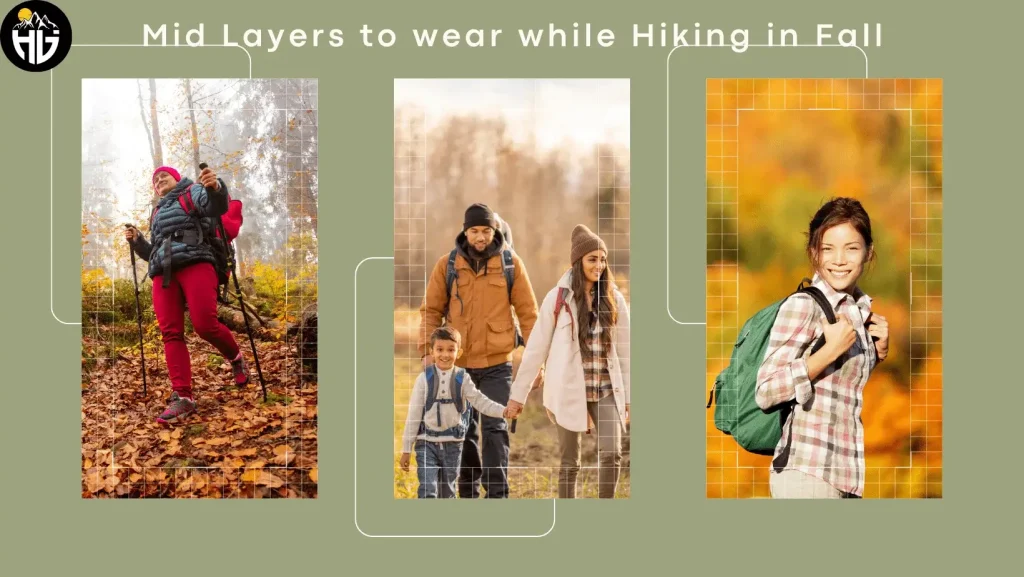
The second layer of clothing you wear over your base layer is a mid-layer. These layers permit moisture to escape while also adding warmth and insulation.
Because they can be easily removed or added to accommodate shifting weather conditions, mid-layers are crucial for fall hiking clothes.
Recommended materials for mid layers
When hiking in fall, synthetic fabrics like polyester, fleece, and wool work best as mid layers.
These materials are perfect for controlling temperature and keeping you dry during your hike because they are lightweight, breathable, and moisture-wicking.
Recommended types of mid layers
Your personal preferences and the weather’s conditions will determine which mid layers you wear. For fall hiking outfits, the following types of mid layers are advised:
Fleece Jackets: Fleece jackets are a great mid-layer for fall hiking because they are breathable, lightweight, and warm. They keep you warm without being cumbersome or constricting.
Softshell Jackets: Softshell jackets are water-, wind-, and breathable-resistant, making them perfect for fall hiking in various weather. They effectively prevent the elements from getting through while still allowing moisture to escape.
Insulated vests: Because they offer extra warmth while allowing for a full range of motion, they are a great mid-layer option for fall hiking clothing. They are simple to layer under a jacket or over a long-sleeved shirt.
Tips for choosing the right mid layer for fall hiking outfits
Take into account the following advice when selecting a mid-layer for fall hiking:
- To prevent overheating, pick a breathable, lightweight mid layer.
- To keep you dry and comfortable, look for materials that wick moisture away from the body and dry quickly.
- Choose a middle layer based on the weather and the warmth you need without overheating or underheating.
- A comfortable mid-layer should go over your base layer and beneath your outer layer.
Using these suggestions, you can pick the ideal mid-layer for your autumn hike and guarantee you’ll be cozy and protected the entire time.
Outer Layers to Wear when Hiking in Fall
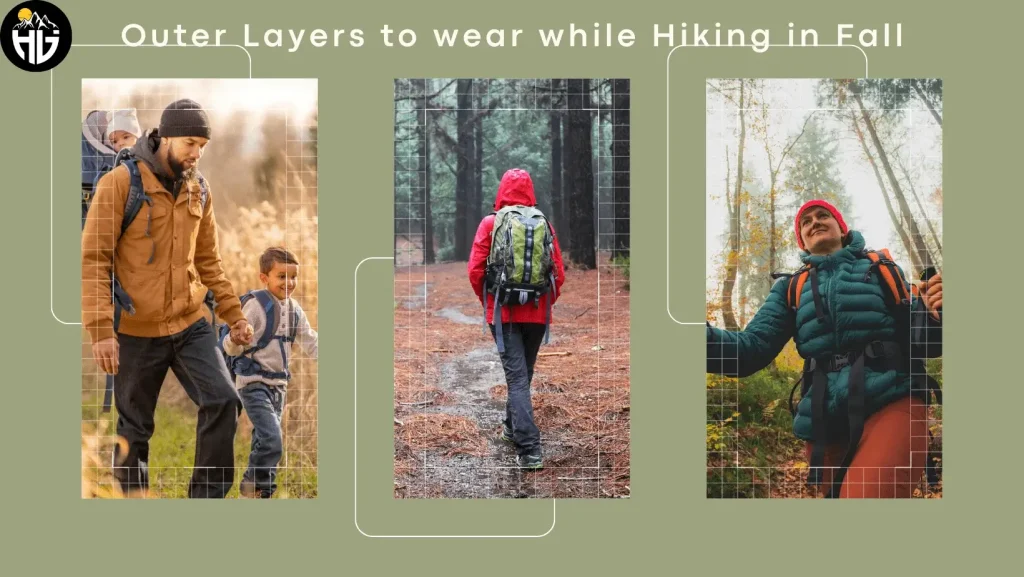
They shield you from the weather, such as wind, rain, and snow, and they also assist in controlling your body’s temperature.
It’s crucial to wear outer layers when hiking in the fall because the weather can be erratic. This will keep you warm and dry.
Recommended materials for outer layers
When selecting materials for outer layers while hiking in the fall, look for breathable, windproof, and water-resistant fabrics.
Gore-Tex, eVent, and other comparable materials are some of the best choices for outer layers. These materials are strong and offer superior weather resistance.
Recommended types of outer layers
The weather and your personal preferences will influence your choice of outer layers. For fall hiking outfits, the following outer layer types are advised:
Rain Jacket: Because it offers protection from wind, rain jacket is necessary for fall hiking. Choose packable, lightweight, and breathable jackets so you can keep them in your backpack when not in use.
Hardshell Jackets: Hardshell jackets are dependable and offer superior wind and rain protection. They can be bulky and constrictive, but they are perfect for hiking outfits in the harsh fall weather.
Softshell Jackets: Softshell jackets are water-, wind-, and breathable-resistant, making them one of the best hiking clothes. They effectively prevent the elements from getting through while still allowing moisture to escape.
Tips for choosing the right outer layer for fall hiking
Always consider the following factors to wear hiking outfits in fall:
- To offer the most protection and comfort, look for breathable, windproof, and water-resistant materials.
- Consider the jacket’s weight and packability to conveniently stow it in your backpack when unused.
- Select a jacket that fits snugly over your base and mid-layers without impairing movement.
- To improve the fit and offer more protection from the elements, look for extra features like adjustable hoods, cuffs, and waistbands.
These suggestions will help you wear hiking outfit for your autumn walk and ensure you are warm, dry and at ease regardless of the weather.
Accessories to Pack while Fall Hiking

Accessories are extra items that can improve your hiking experience and offer more protection from the elements while hiking in fall. While unnecessary, accessories can significantly impact your comfort and safety while hiking.
Recommended accessories for fall hiking
The following are some suggested hiking accessories for the fall:
Hats: By keeping you warm in cold weather and shielding you from the sun’s rays in hot weather, hats can help you regulate your body temperature.
Gloves: When hiking in the fall, gloves can keep your hands warm and shield them from the wind and colder weather.
Scarves and neck gaiters: These items can shield the wind and cold from your face and neck.
Hiking Leggings: when they are combined with hiking pants, they can be very helpful in keeping your upper body warm.
Sunglasses: Sunglasses can shield your eyes from glare and dangerous UV rays.
Headlamps or flashlights are recommended in the fall because the daylight hours can disappear quickly. If your hike lasts longer than anticipated, a headlamp or torch can be helpful.
Tips for choosing the right accessories for fall hiking
Take into account the following advice when selecting accessories for fall hiking:
- Wear hiking accessories made from breathable and moisture-wicking materials to stay dry and comfortable.
- To conveniently store your accessories in your backpack when not in use, look for light and packable items.
- When selecting accessories, consider the terrain of your walk and the weather. Consider wearing waterproof accessories, for instance, if you’ll be hiking in wet conditions.
- Select accessories that are well-fitting and comfortable to wear for a long time.
You can improve your hiking experience, stay safe and comfortable, and be ready for any weather conditions you may run into by paying attention to these suggestions and selecting the appropriate accessories for your hike.
Hiking Boots to Wear in Fall Trekking
Fall hiking is a favorite pastime for many outdoor enthusiasts. It’s the perfect time of year to hit the trails because of the cooler temperatures, stunning scenery, and vibrant foliage.
However, having the appropriate shoes before starting a hike is important. Proper footwear can offer stability, traction, and comfort while preventing injury.
This section will discuss the value of wearing the right hiking shoes when hiking in the fall, provide a list of footwear options to consider, and provide advice on selecting the footwear that will best meet your needs.
Importance of Proper Footwear for Hiking in the Fall
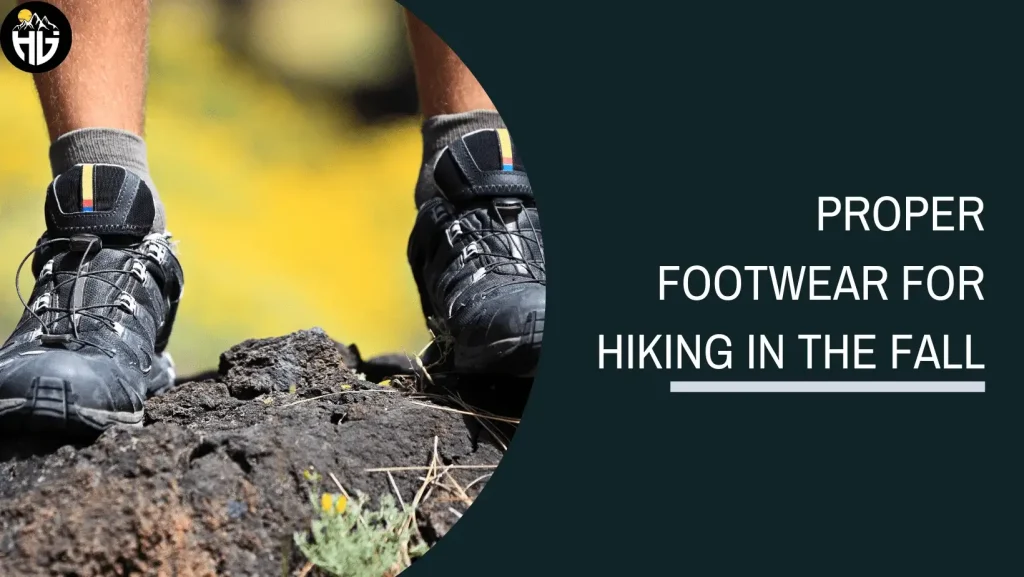
Fall hiking can present several difficulties, such as muddy, slippery terrain, chilly weather, and potentially dangerous trail conditions. You can overcome these difficulties and gain the following advantages by wearing appropriate footwear:
Support: Your feet, ankles, and arches are supported by appropriate footwear. This can lessen the possibility of ankle twists, sprains, and other injuries.
Traction: Walking on the muddy, slick ground in the fall can be challenging. Good traction is provided by appropriate footwear, which can help avoid falls.
Comfort: Hiking can be long and exhausting, particularly in the fall when it’s cooler outside. The ideal pair of shoes should be supportive and cushioned well enough to keep your feet happy and comfortable.
Types of Footwear to Consider for Fall Hiking
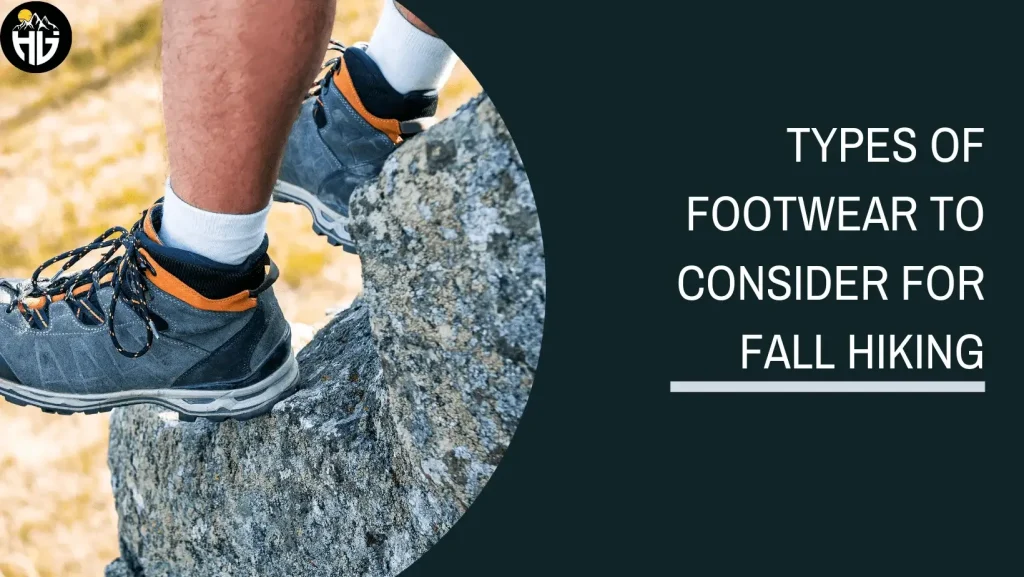
There are two main categories of hiking shoes to think about when choosing fall hiking shoes:
Hiking boots: Your feet, ankles, and shins are intended to be supported and safeguarded by them. From low-cut to mid-cut to high-cut, they are available in various heights and offer various degrees of ankle support. Waterproof hiking boots with good quality hiking socks are highly recommended by experts.
Trail shoes: Alternatives to most hiking boots include trail shoes, which are lighter and more flexible. They have good traction and support and are made for hiking on less difficult trails. Some hikers may find that the lower cut of trail shoes makes them more comfortable than hiking boots.
Tips for Choosing the Right Footwear for Fall Hiking

Take into account the following advice when picking the appropriate boots for fall hiking:
Trail conditions and difficulty level: Wear hiking boots that suit the trail’s conditions and difficulty level. For support and protection, hiking boots may be a better option if hiking on a challenging trail with many rocks and steep inclines.
Fit and comfort: Make sure your shoes are comfortable and have enough space for your toes to move around. Try various sizes and styles and stroll around the store to ensure a proper fit. Consider wearing shoes with removable insoles so that, if necessary, you can insert custom orthotics.
Weight: Consider the weight of your shoes because while they might be more supportive, heavier boots can be uncomfortable to wear all day. Shorter hikes on less difficult terrain might benefit from lighter trail shoes.
Traction and waterproofing: Check the sole for good traction, and if you’re hiking through wet terrain, think about wearing waterproof hiking boots or water-resistant membrane. Look for features like a Vibram sole or Gore-Tex lining for the best traction and waterproofing.
Foot conditions: If you have specific foot issues, like plantar fasciitis or bunions, you might ask a podiatrist for advice on appropriate footwear. They can offer professional guidance on the best shoes for your particular requirements.
Hiking Gear to pack for trekking in fall
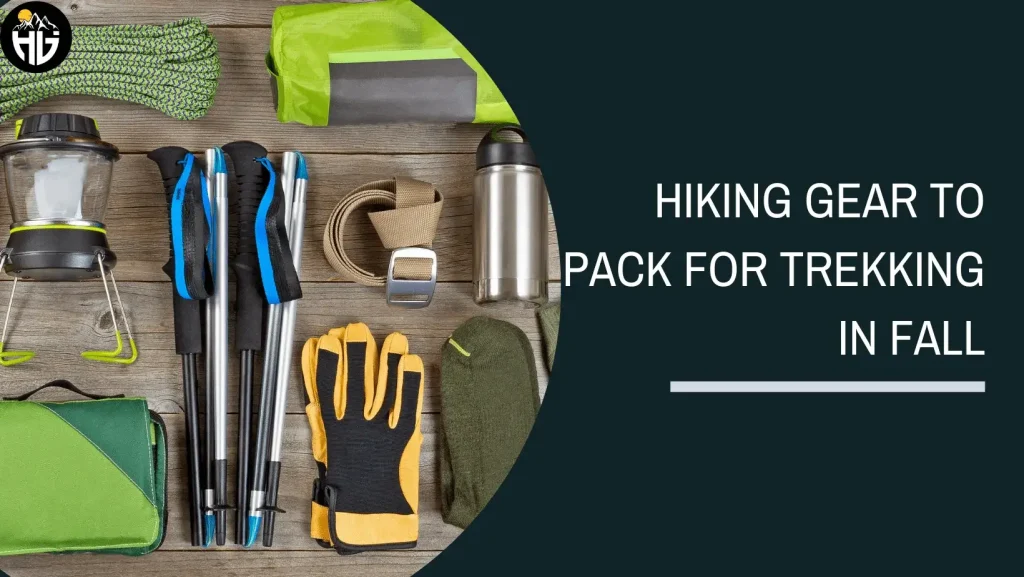
Other than what to wear hiking in fall, there are some factors you should consider before going on a hike. Those factors are explained below:
With crisp air, vibrant foliage, and fewer tourists, fall is a wonderful time to hike. However, having the appropriate equipment is essential before starting a hike.
The right equipment can increase your hiking experience’s comfort, convenience, and safety.
The necessary hiking equipment, such as a backpack, hydration system, trekking poles, headlamps, and first aid kit, will be discussed in this article.
Additionally, we’ll go over the value of each item and how it can enhance your hiking experience.
Backpack
Select a backpack with padded straps and a waist belt to evenly distribute the weight. Choose a backpack with many pockets and compartments to organize and secure your outdoor gear.
You can stay hydrated without stopping to get a water bottle out of a backpack with a compartment for a hydration system.
Check Out Our Hiking Backpacks!
Hydration Method
On a hike, it’s important to stay hydrated, especially if you’re hiking in a dry environment or at a high elevation. You can drink water while moving using a hydration system, such as a water bottle or bladder, eliminating the need to stop and remove your backpack.
Try to find a hydration system that is simple to use, has a good flow rate, and is simple to keep up with.
Trekking Poles
Trekking poles can offer steadiness, support, and balance on a hike. The impact on your knees and joints can be lessened, especially when hiking downhill.
Look for trekking poles with adjustable grips, wrist straps, and comfortable grips. Trekking poles that collapse are another excellent choice because they can be conveniently stored in your backpack when not in use.
Headlamp
Fall hikes require a headlamp, especially if you intend to go early in the day or late at night. You can easily and safely navigate the trail with its hands-free lighting.
Find a portable headlamp that has an LED light that is bright and has adjustable settings. Just in case, pack extra batteries or a backup light source.
Medical Kit
Any hike requires a first aid kit because you can treat minor illnesses or injuries on the trail. A first aid kit should contain bandages, antiseptic wipes, painkillers, and insect repellent.
Adapt your first aid kit to your unique requirements and any existing medical conditions.
The right equipment is required for a safe and enjoyable fall hiking experience. For a hike, you’ll need to bring a backpack, hydration system, trekking poles, headlamps, and a first aid kit, among other things.
Each tool has a specific use and can enhance your hiking experience by bringing convenience, comfort, and safety.
Consider the trail conditions, the weather, and your unique needs when preparing for a hike to ensure a successful and enjoyable hike.
Food and Water to Pack

Any hiking in fall trip requires staying hydrated and fed, but a fall hike is especially critical due to the cooler temperatures and drier air.
Maintaining Proper Hydration and Nutrition
Proper nutrition and hydration are crucial for a fruitful and enjoyable fall hike. Water is essential for the body’s ability to control temperature, lubricate joints, and transport nutrients.
Hikers who don’t drink enough water may become fatigued, get headaches, feel lightheaded, and experience other dehydration symptoms.
Like food supplies the energy required for exercise, it also helps control blood sugar levels. High-energy snacks can help maintain energy levels throughout the day and offer a quick energy source during a hike.
What to Pack for Food and Water
The most important item to bring on a fall hike is water. Given the length and difficulty of the hike, as well as the weather, bring enough water to stay hydrated throughout the day.
Drinking at least 2 liters of water daily is a good rule of thumb, but your needs may differ. While hydration packs enable hands-free hydration while moving, water bottles are a practical and portable option.
Pack high-energy snacks and water for a quick fuel source during the hike.
Trail mix, energy bars, jerky, and fresh or dried fruit are all good choices. Pack enough snacks to keep you going throughout the day, and think about the nutritional value of each one.
Avoid processed or sugary snacks that can cause a sugar crash, and opt instead for snacks with a balanced amount of carbs, protein, and healthy fats.
What Pants Should I Wear Hiking in Fall?
When hiking in the fall, it’s important to wear pants that will keep you comfortable and protected from the elements. Here are some factors to consider when choosing your hiking pants:
Material: Wear hiking pants made from a lightweight and breathable fabric such as nylon or polyester. These materials dry quickly and wick away moisture, which will help keep you comfortable on the trail.
Fit: Look for pants that fit well and allow for a full range of motion. You want to be able to move freely without feeling constricted or restricted.
Length: Wear hiking pants that are long enough to protect your legs from brush, rocks, and other hazards on the trail. A full-length pant or a convertible pant with zip-off legs will give you the flexibility to adapt to changing weather conditions.
Warmth: If you’re hiking in cooler temperatures, wear hiking pants with some insulation. Fleece-lined pants or thermal leggings can provide an extra layer of warmth without adding too much bulk.
Color: Choose pants in earthy tones that blend in with the natural environment. Avoid bright colors that may scare off wildlife or attract unwanted attention.
Overall, it’s important to choose pants that are comfortable, durable, and appropriate for the weather conditions you’ll encounter on your hike.
Conclusion
In conclusion, packing the right gear and clothing is essential for a successful and enjoyable hiking adventure. From proper footwear to hydration and nutrition, every item plays a crucial role in ensuring your safety and comfort on the trail.
By following the tips and recommendations in this guide, you can make informed choices and be well-prepared for your next fall hike. Remember to research the trail ahead of time, check the weather conditions, and pack accordingly.
Frequently Asked Questions
What kind of socks do I need for hiking in fall?
For fall hiking, you should wear hiking socks made from moisture-wicking materials such as wool or synthetic blends. They should be thick enough to provide cushioning and insulation but not too thick to make your feet hot. Consider wearing mid- to high-cut wool socks that protect your ankles and prevent blisters.


